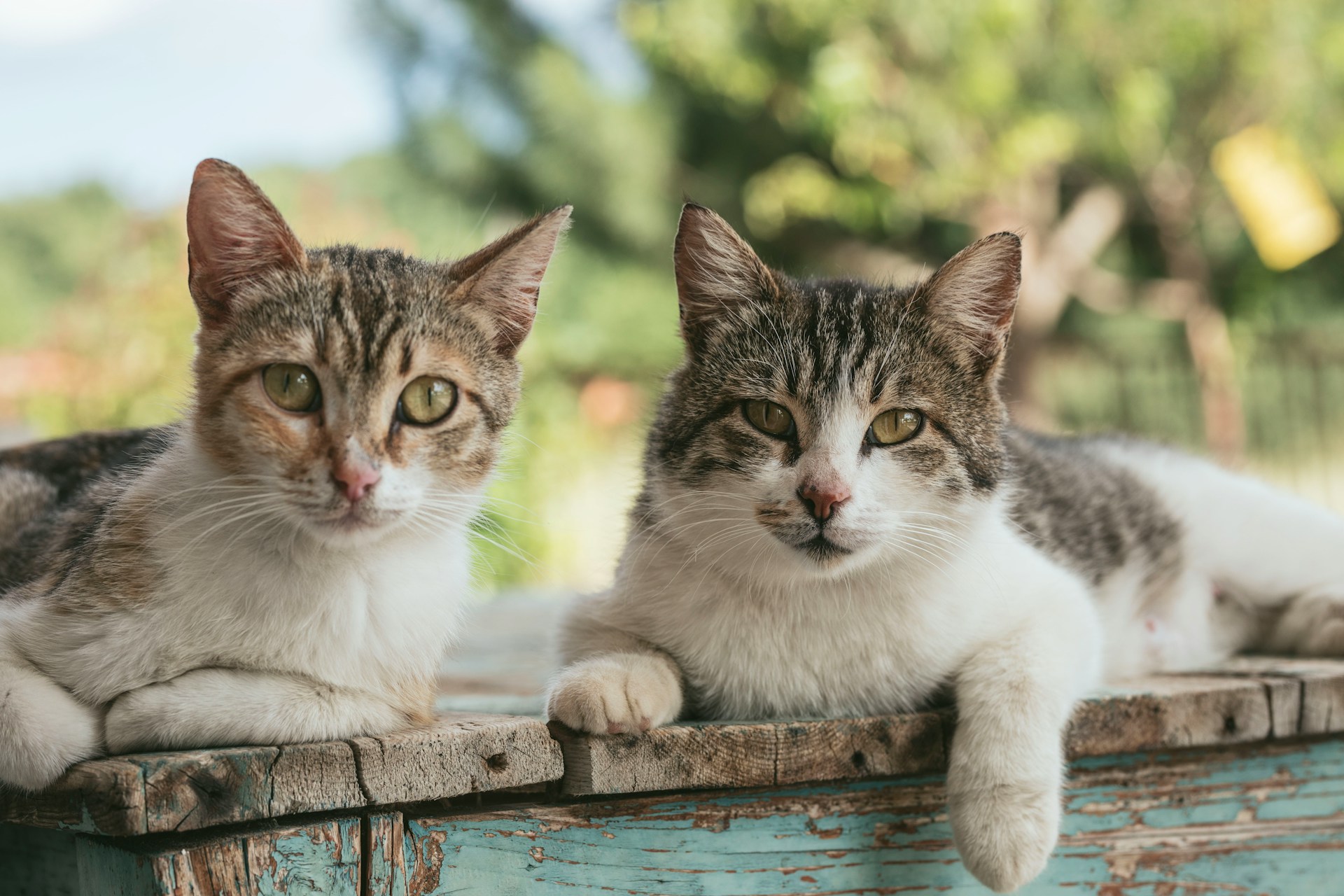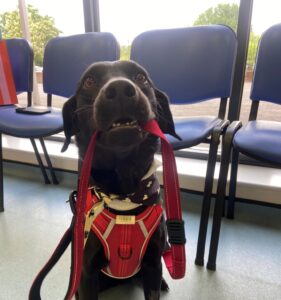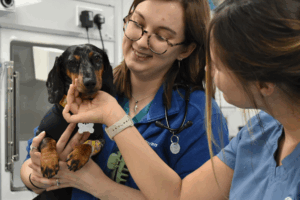Are you considering welcoming a furry feline friend into your home? Understanding the characteristics of the most common cat breeds can help you make an informed decision about which breed might be the best fit for you and your lifestyle.
Here’s a look at some of the most beloved cat breeds in the UK, known for their unique traits and endearing personalities.
British Shorthair
The quintessentially British breed, the British Shorthair, has a distinctive stocky body, dense coat and charming, round face. This breed is known for being affectionate, making it a perfect family pet. They are notably calm and easygoing, which complements a variety of household environments.
Common issues to be aware of:
- Heart disease – hypertrophic cardiomyopathy (HCM): British Shorthairs can have a genetic predisposition for heart disease. The most common form is HCM, which involves a thickening of the heart muscle.
- Polycystic kidney disease (PKD): PKD is caused by a defective gene. The disease was first recognised in Persians and is seen occasionally in other breeds, including British Shorthairs.
Siamese
The Siamese cat, with its striking blue almond-shaped eyes and elegant, muscular body, is a marvel of feline beauty and grace. This breed is known for its intelligence, playful nature and often engages in lengthy conversations with their owners. Siamese cats thrive on social interactions and form strong bonds with their families.
Common issues to be aware of:
- Gastro-intestinal issues: Conditions such as inflammatory bowel disease can affect Siamese cats, which is caused by a reaction to chronic irritation of the stomach or intestines.
- Asthma: Like in humans, feline asthma is a chronic inflammation of the small passageways in the lungs, with breeds like the Siamese having a genetic disposition to this.
Ragdoll
Ragdolls are known for their mesmerising blue eyes and beautiful semi-long hair, they are gentle and often seek physical affection, making them ‘lap cats’. Ragdolls are ideal for homes that can provide them with plenty of love and cuddles.
Common issues to be aware of:
- Gastro-intestinal issues: As with Siamese cats, conditions such as inflammatory bowel disease can be fairly common in Ragdolls.
- Respiratory tract disorders: Due to their flat faces and short noses, respiratory problems can be relatively common in Ragdolls.
- Coats: While their grooming requirements are a little lower maintenance than other long-haired breeds, Ragdolls still need lots of care. It’s recommended that they have home grooming sessions at least twice per week to help clear shedding hair and smooth any tangles.
Bengal
The Bengal cat has a stunning wild appearance with a coat that resembles leopards and ocelots. This breed is vibrant and athletic, requiring regular exercise and mental stimulation. Bengals are particularly interactive and enjoy games that challenge their agility and intelligence.
Common issues to be aware of:
- Progressive retinal atrophy (PRA): PRA is a congenital disease that causes progressive degeneration of the retina. Bengals born with a degenerative gene will go blind gradually.
- Heart disease – hypertrophic cardiomyopathy (HCM): Similar to British Shorthairs, HCM is the most common form of heart disease to affect Bengals.
Maine Coon
As one of the largest domesticated cat breeds, Maine Coons are distinguished by their tufted ears, bushy tails and luxurious coats. They are known as gentle giants and possess a friendly and sociable nature. Maine Coons are excellent companions for children and get along well with other pets.
Common issues to be aware of:
- Orthopaedic issues: One of the most common joint, bone and ligament problems that Maine Coons suffer from is hip dysplasia, where the ball and socket of the hip joint do not develop properly. In some cases, hip dysplasia may not show until it has progressed to secondary arthritis.
- Asthma: Similar to other breeds, Maine Coons can suffer from problems in the lower respiratory tract, such as feline asthma.
- Heart disease – hypertrophic cardiomyopathy (HCM): Maine Coons seem to have a high prevalence of HCM, which can cause heart failure and thromboembolism (where a blood clot becomes dislodged and travels through the aorta before becoming stuck elsehwhere).
Scottish Fold
The Scottish Fold is easily recognised by its unique folded ears, giving it a cute owl-like appearance. These cats are incredibly affectionate and calm, preferring quiet environments where they can spend time with their human companions. Their gentle and easygoing nature makes them suitable for families and single-person households alike.
Common issues to be aware of:
- Osteochondrodysplasia (Scottish Fold disease): Osteochondrodysplasia is a disease caused by the mutation that gives this breed their folded ears. It changes the way their cartilage forms, and affects all cats bred from Scottish Folds.
- Ear disease/infections: Their abnormal ear shape can increase the risk of disease and infections in Scottish Folds.
Sphynx
The almost-hairless Sphynx cat stands out due to its exposed skin and pronounced wrinkles. While this doesn’t make them hypoallergenic, they are known to produce fewer allergens than many fluffy cat breeds. Sphynxes are known for their loyalty and playful attitudes, and love to seek warmth and affection from their owners.
Common issues to be aware of:
- Skin problems: Sphynx’s have a predisposition to various skin problems. Common issues include urticaria pigmentosa, a genetic condition that causes red, itchy bumps on the skin, and seborrhea, in which excess oil production creates greasy, itchy patches. A veterinarian can perform a genetic test for urticaria pigmentosa.
- Heart disease – hypertrophic cardiomyopathy (HCM): Like with other breeds, HCM is a common form of heart disease to affect the Sphynx.
What about Moggies?
The domestic cat which is commonly known as a ‘Moggie’ is the most common cat living in UK homes. However, this cat is of no particular breed and has instead descended from the African Wildcat. Because of their random breeding, they do not have a definite appearance or temperament, so can come in all sizes, coat lengths and colours – from black and white to tabby or tortoiseshell.
Choosing the right breed for you
When selecting a cat breed, don’t just consider the cat’s physical characteristics and personality traits but also your living situation, the cat’s activity level, and the amount of time you can dedicate to caring for and interacting with your pet. Each cat breed has unique needs and qualities, and finding a compatible companion is essential.
For further advice and quality pet care, contact your local St Kitts practice:
St Kitts Vets Hartley Wintney: 01252 844044
St Kitts Vets Basingstoke: 01256 844944
Crookham Park Veterinary Centre: 01252 913990
Firgrove Veterinary Centre: 01252 877799





